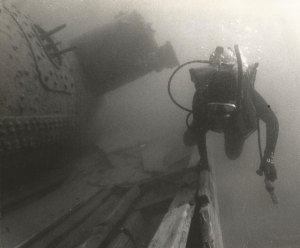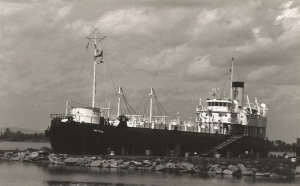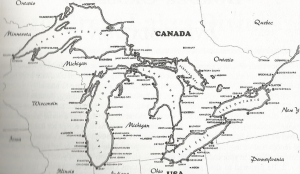Treasure Ships of the Great Lakes

Diver explores the remains of an unidentified coal carrier in Georgian Bay, Tobermory, Lake Huron. Photo Credit: Bill Hughes.
While vessels laden with barley, wheat, rye and corn were unlikely candidates for salvage, iron ore, coal and whiskey were more desirable. Coal, usually shipped from Pennsylvania, Ohio, Illinois, Kentucky and West Virginia, was burned in the furnaces and smelters in the Lake Superior regions of Michigan, Wisconsin and Minnesota. It was also the primary fuel used to heat most homes. Iron ore had less value, but its counterpart, pig iron, was a Great Lakes treasure.

Whaleback steamer SS METEOR, typical of the ships that carried coal on the Great Lakes. Photo Credit: Head of the Lakes Maritime Society.
When the steamer, LINDEN, went down in the St. Clair River in 1905, the Port Huron Wrecking Company used pontoons and cofferdams to salvage 1,000 tons of coal, and eventually raised the vessel.
In 1913, the HOWARD M. HANNA, JR. was transporting 9,000 tons of coal when it foundered on the rocks of Lake Huron. By the time the insurance company settled the lost cargo claim and hired a salvor, local residents had off-loaded most of the coal. It was reported that locals from Port Austin, Michigan, were still burning some of it 10 years later.
Not all of the lakes’ treasured coal was salvaged. In 1910, the steamer, LANGHAM, caught fire in Bete Grise Bay, Lake Superior, and sank with no losses except for a large cargo of coal. Neff Shipping Company from Milwaukee sent a tugboat and a barge hundreds of miles to the Northern Michigan wreck site, but fierce storms forced the crews to quit after a brief attempt at salvage.Cargo vessels have sailed the Great Lakes for more than 300 years. While Caribbean divers were searching for gold doubloons from Spanish galleons, the fresh water salvors were searching for something more practical—resources used in home and industry. But no matter what they retrieved: new cars, whiskey, even crates of cheese, King Coal remained the most coveted prize of all.
8 Comments
Submit a Comment
All Rights Reserved © | National Underwater and Marine Agency
All Rights Reserved © | National Underwater and Marine Agency
Web Design by Floyd Dog Design
Web Design by Floyd Dog Design


“I enjoyed “Treasure Ships of the Great Lakes.”Could you recommend an intermediate depth shipwreck dive in Lake Michigan? One that has an interesting history? Thank you.
I recommend the Sandusky, wooden brig lost in 1848 in the staits of Mackinac, a narrow stretch of water connecting Lake Michigan and Lake Huron. The wreck rests upright and you can reach the deck at 70 feet and see the ram’s head figurehead just beneath the bowsprit. There’s also deadeyes, broken masts, a windlass, pumps, hatches and other sights. This area has many other shipwrecks in case this one doesn’t suit your needs.
are thereany more gold or silver bullion ships sunk in lake michigan have they all been foundyet thanks jon macvean
How about the Marquette and Bessemer #2 that is reportedly (according to current internet posts) still missing in Lake Erie? At 350 feet long, there’s only a few places in the entire lake that could hide this thing for 100 years.
Given the known history of the ship’s end, it is almost certainly in the deep basin off Long Point, and probably covered with allot of silt and sand.
One would think that a competent Navy crew on a P-3 Orion using magnetic anomaly detection could find this much iron in a day or less.
are there any treasure ships at the bottom of Lake Ontario–considering the War of 1812 and the many battles/ship sunk surrounding this you would think there would be British/American ships with payroll cargos etc at the bottom. The deepest part of Lake Ontario is not that far off Oswego/Sodus Point both areas where lake battles occurred
The original name board for the ill-fated bootlegging ship “City of Dresden” is up for auction Feb. 10, 2018, at millerandmillerauctions.com. It is autographed by the government liquor inspector who enforced the Temperance Act.
Thanks, that is very interesting about the City of “Dresden.” Let me know if you hear anything more about it. I’ll keep my eye out too.
This is VERY interesting. Please keep me posted on what evolves. Many thanks!